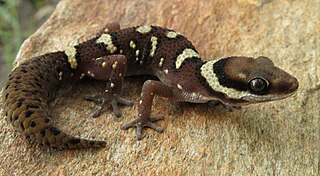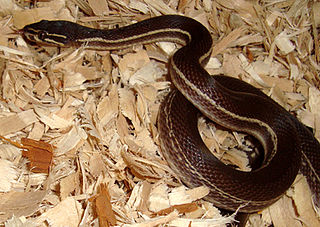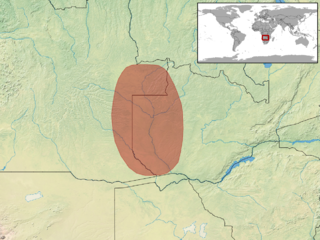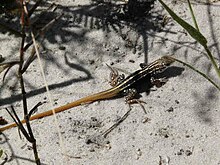
Lygodactylus is a genus of diurnal geckos with 72 species. They are commonly referred to as dwarf geckos. They are mainly found in Africa and Madagascar although two species are found in South America. Lygodactylus picturatus, the best known species, is found in Kenya and commonly known as the white-headed dwarf gecko. Recently, illegal importation from Tanzania of brightly colored, Lygodactylus williamsi, known as electric blue geckos, has been gaining attention for Lygodactylus geckos in the reptile trade.

Hemidactylus is a genus of the common gecko family, Gekkonidae. It has 191 described species, newfound ones being described every few years. These geckos are found in all the tropical regions of the world, extending into the subtropical parts of Africa and Europe. They excel in colonizing oceanic islands by rafting on flotsam, and are for example found across most of Polynesia. In some archipelagoes, cryptic species complexes are found. Geckos like to live in and out of houses. They have been introduced to Australia.

Pachydactylus is a genus of insectivorous geckos, lizards in the family Gekkonidae. The genus is endemic to Africa, and member species are commonly known as thick-toed geckos. The genus also displays rich speciation, having 57 distinct species identified when compared to other closely related gecko genera like Rhoptropus, most of which have emerged since 35Ma. It has been suggested that the reason for this rich speciation not from adaptive radiation nor nonadaptive radiation, but that the genus represents a clade somewhere between the two drivers of speciation. P. bibronii geckos have been used by NASA as animal models for experimentation.

The genus Cordylus includes a wide variety of species of small to medium spiny lizards from Africa, collectively called girdle-tailed lizards or girdled lizards. All are diurnal and ovoviviparous. Most species are rupicolous (rock-dwelling), while a few species are arboreal or live in burrows. They defend themselves with osteoderms and by quickly retreating into rock crevices or burrows. Many species live in groups, and males defend territories.

Panaspis is a genus of skinks, commonly called lidless skinks or snake-eyed skinks, endemic to Sub-saharan Africa.

Nucras is a genus of African lacertid lizards, commonly called sandveld lizards.

Pedioplanis is a genus of lizards in the family Lacertidae. All species of Pedioplanis are endemic to southern Africa.

The armadillo girdled lizard, also commonly known as the armadillo lizard, the armadillo spiny-tailed lizard, and the golden-armadillo lizard, is a species of lizard in the family Cordylidae. The species is endemic to desert areas along the western coast of South Africa. In 2011, it was moved to its own genus based on molecular phylogeny, but formerly it was included in the genus Cordylus.
Kasner's dwarf burrowing skink, also known commonly as Kasner's burrowing skink, is a species of lizard in the family Scincidae.

Trachylepis is a skink genus in the subfamily Mabuyinae found mainly in Africa. Its members were formerly included in the "wastebin taxon" Mabuya, and for some time in Euprepis. As defined today, Trachylepis contains the clade of Afro-Malagasy mabuyas. The genus also contains a species from the Brazilian island of Fernando de Noronha, T. atlantica, and may occur in mainland South America with Trachylepis tschudii and Trachylepis maculata, both poorly known and enigmatic. The ancestors of T. atlantica are believed to have rafted across the Atlantic from Africa during the last 9 million years.

Hyperolius parallelus, also known as the Angolan reed frog, is a species of frog in the family Hyperoliidae. It is found in Southern and Central Africa. It is part of the so-called Hyperolius viridiflavus species complex and has a complex history of taxonomic treatments.

The Transvaal grass lizard, also known as the coppery grass lizard and Transvaal snake lizard is a species of lizard in the genus Chamaesaura. It is found in southern African grasslands and on slopes. The Transvaal grass lizard is ovoviparous. The scientific name refers to its copper colour.

Boaedon is a genus of African lamprophiids consisting of the "brown" house snakes. The genus was originally described by Duméril but the species contained were reclassified as Lamprophis by Fitzinger in 1843, this taxonomy remained widely accepted until November 2010 when a phylogenetic study was published by C.M.R Kelly et al. who resurrected the Boaedon clade. Although commonly regarded as belonging to the Colubridae, primary literature usually lists them, and related species, as belonging to the family Lamprophiidae within the superfamily which includes the venomous cobras and mambas, Elapoidea.

Heliobolus lugubris, also known commonly as the bushveld lizard, mourning racerunner, or the black and yellow sand lizard, is a species of lizard in the family Lacertidae. The species is native to southern Africa.

Zygaspis nigra is a worm lizard species in the family Amphisbaenidae. The species is endemic to southern Africa.
Heliobolus spekii, also known commonly as Speke's sand lizard, is a species of lizard in the family Lacertidae. The species is native to East Africa and the Horn of Africa. There are three recognized subspecies.
Pedioplanis breviceps, known commonly as the short-headed sand lizard, the short-headed sandveld lizard, and Sternfeld's sand lizard, is a species of lizard in the family Lacertidae. The species is endemic to Namibia.
Pedioplanis gaerdesi, known commonly as the Kaokoland sand lizard, the Kaokoveld sand lizard, and Mayer's sand lizard, is a species of lizard in the family Lacertidae. The species is endemic to Namibia.
Pedioplanis huntleyi is a species of lizard in the family Lacertidae. The species is endemic to Angola.
Pedioplanis inornata, known commonly as the plain sand lizard or the western sand lizard, is a species of lizard in the family Lacertidae. The species is endemic to Southern Africa.














